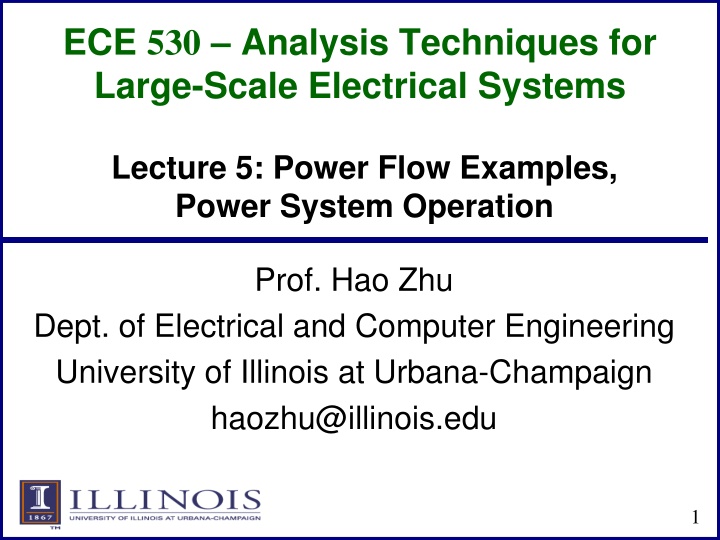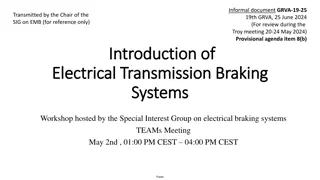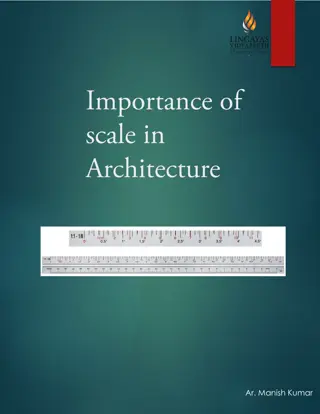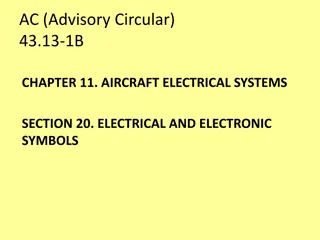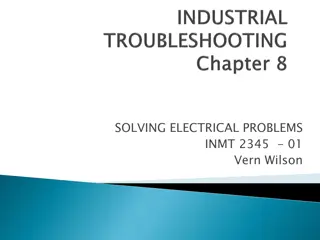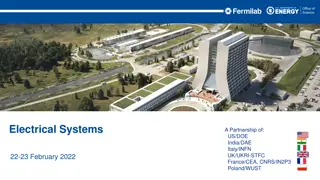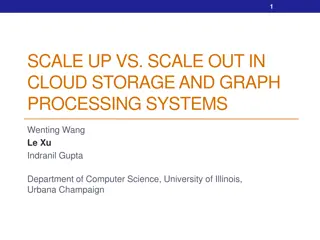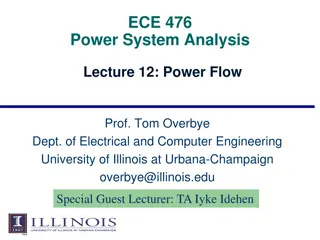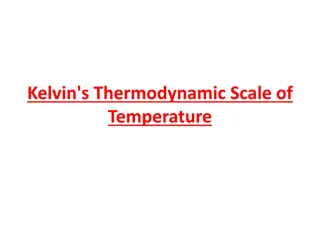Power Flow Analysis Techniques for Large-Scale Electrical Systems
Using the Newton-Raphson method, this lecture explores power flow examples and system operation in large-scale electrical systems. A two-bus example is analyzed to determine voltage magnitude and angle, showcasing power balance equations and iterative calculations. The process of calculating power flow Jacobian and successive iterations is detailed, leading to the solution for the voltage parameters at bus two.
Download Presentation

Please find below an Image/Link to download the presentation.
The content on the website is provided AS IS for your information and personal use only. It may not be sold, licensed, or shared on other websites without obtaining consent from the author.If you encounter any issues during the download, it is possible that the publisher has removed the file from their server.
You are allowed to download the files provided on this website for personal or commercial use, subject to the condition that they are used lawfully. All files are the property of their respective owners.
The content on the website is provided AS IS for your information and personal use only. It may not be sold, licensed, or shared on other websites without obtaining consent from the author.
E N D
Presentation Transcript
ECE 530 Analysis Techniques for Large-Scale Electrical Systems Lecture 5: Power Flow Examples, Power System Operation Prof. Hao Zhu Dept. of Electrical and Computer Engineering University of Illinois at Urbana-Champaign haozhu@illinois.edu 1
Announcements HW1 due 9/11 Some of the material from this lecture is in T.J. Overbye, Power System Simulation: Understanding Small and Large-System Operation, IEEE Power and Energy Magazine, 2004; also in M. Crow, G. Gross, P.W. Sauer, Power System Basics for Business Professionals in Our Industry, IEEE Power and Energy Magazine, 2003 2
Two Bus Newton-Raphson Example For the two bus power system shown below, use the Newton-Raphson power flow to determine the voltage magnitude and angle at bus two. Assume that bus one is the slack and SBase = 100 MVA. Line Z = 0.1j One 1.000 pu Two 1.000 pu 0 MW 0 MVR 200 MW 100 MVR 10 10 j 10 10 j j j 2 = = x Y bus V 2 3
Two Bus Example, contd General power balance equations n = + = P ( cos sin ) V V G B P P i i k ik ik ik ik Gi Di = 1 k n = = Q ( sin cos ) V V G B Q Q i i k ik ik ik ik Gi Di = 1 k Bus two power balance equations (10sin V V ) 2.0 + = 0 2 1 2 2 ( 10cos + (10) 1.0 + = ) 0 V V V 2 1 2 2 4
Two Bus Example, contd = ) 2.0 + = x P ( ) (10sin 0 V 2 2 2 2 = ( 10cos + (10) 1.0 + = ( ) x ) 0 Q V V 2 2 2 2 Now calculate the power flow Jacobian P ( ) = = P ( ) x x 2 2 V 2 2 x 2 ( ) x J x Q ( ) Q ( ) 2 2 V 2 2 2 + 10 10 cos sin 10sin V V 2 2 2 20 10cos V 2 2 2 2 5
Two Bus Example, First Iteration 0 1 (0) = = x Set 0, guess v Calculate ) 2.0 + (10sin V 2.0 1.0 2 2 V (0) = = x f( ) 2 ( 10cos + + ) (10) 1.0 + V 2 2 2 10sin 10 10 cos sin V V 10 0 0 2 2 2 20 (0) = = J x ( ) 10cos V 10 2 2 2 2 12.0 1.0 0 1 10 0 0 0.2 0.9 (1) = = x Solve 10 6
Two Bus Example, Next Iterations 0.9(10sin( 0.2)) 2.0 + 0.212 0.279 (1) = = x f( ) 2 + 10 1.0 + 0.9( 10cos( 0.2)) 8.82 1.788 0.9 1.986 8.199 (1) = J x ( ) 1 0.2 0.9 = = 8.82 1.788 1.986 8.199 0.212 0.279 0.236 0.8554 0.233 0.8586 (2) = = x 0.0145 0.0190 0.0000906 0.0001175 (2) (3) = x x f( ) (3) = x f( ) Done! V 0.8554 13.52 2 7
Two Bus Solved Values Once the voltage angle and magnitude at bus 2 are known we can calculate all the other system values, such as the line flows and the generator reactive power output 200.0 MW 168.3 MVR -200.0 MW -100.0 MVR Line Z = 0.1j One 1.000 pu Two 0.855 pu -13.522 Deg 200.0 MW 168.3 MVR 200 MW 100 MVR PowerWorld Case Name: Bus2_Intro 8
Two Bus Case Low Voltage Solution This case actually has two solutions! The second "low voltage" is found by using a low initial guess. = = 0 (0) x Set 0, guess v 0.25 Calculate ) 2.0 + (10sin V 2 2 2 V (0) = = x f( ) 2 0.875 ( 10cos + (10) 1.0 + + ) V 2 2 2 10sin 10 10 cos sin V V 2.5 0 0 2 2 2 20 (0) = = J x ( ) 10cos V 5 2 2 2 2 9
Low Voltage Solution, cont'd 1 0.8 0 2.5 0 0 2 (1) = = x Solve 0.875 0.25 1.462 0.534 5 0.075 0.921 0.220 1.42 0.2336 (2) (2) (3) = = = f x x x ( ) Low voltage solution 200.0 MW 831.7 MVR -200.0 MW -100.0 MVR Line Z = 0.1j One 1.000 pu Two 0.261 pu -49.914 Deg 200.0 MW 831.7 MVR 200 MW 100 MVR 10
Practical Power Flow Software Note Most commercial software packages have built in defaults to prevent convergence to low voltage solutions. One approach is to automatically change the load model from constant power to constant current or constant impedance when the load bus voltage gets too low In PowerWorld these defaults can be modified on the Tools, Simulator Options, Advanced Options page; note you also need to disable the Initialize from Flat Start Values option The PowerWorld case Bus2_Intro_Low is set solved to the low voltage solution Initial bus voltages can be set using the Bus Information Dialog 11
Two Bus Region of Convergence Slide shows the region of convergence for different initial guesses of bus 2 angle (x-axis) and magnitude (y-axis) Red region converges to the high voltage solution, while the yellow region converges to the low voltage solution 12
Power Flow Fractal Region of Convergence Earliest paper showing fractal power flow regions of convergence is by C.L DeMarco and T.J. Overbye, Low Voltage Power Flow Solutions and Their Role in Exit Time Bases Security Measures for Voltage Collapse, Proc. 27th IEEE CDC, December 1988 A more widely known paper is J.S. Thorp, S.A. Naqavi, Load-Flow Fractals Draw Clues to Erratic Behavior, IEEE Computer Applications in Power, January 1997 13
PV Buses Since the voltage magnitude at PV buses is fixed there is no need to explicitly include these voltages in x or write the reactive power balance equations the reactive power output of the generator varies to maintain the fixed terminal voltage (within limits) optionally these variations/equations can be included by just writing the explicit voltage constraint for the generator bus |Vi | Vi setpoint = 0 14
Three Bus PV Case Example For this three bus case we have = + + x x ( ) ( ) Q P P P P P P 2 2 2 2 G D = = x ( ) f x 0 3 3 3 Q 3 G + D ( ) x V 2 2 2 D Line Z = 0.1j 0.941 pu -7.469 Deg One 1.000 pu Two 200 MW 100 MVR 170.0 MW 68.2 MVR Line Z = 0.1j Line Z = 0.1j Three 1.000 pu 30 MW 63 MVR 15
Modeling Voltage Dependent Load So far we've assumed that the load is independent of the bus voltage (i.e., constant power). However, the power flow can be easily extended to include voltage depedence with both the real and reactive l is done by making P and Q a function of oad. This V : Di Di i n + + = ( cos sin ) ( ) 0 V V G B P P V i k ik ik ik ik Gi Di i = 1 k n + = ( sin cos ) ( ) 0 V V G B Q Q V i k ik ik ik ik Gi Di i = 1 k 16
Voltage Dependent Load Example In previous two bus example now assume the load is constant impedance, so 2 = ) 2.0 + = x P ( ) (10sin 0 V V 2 2 2 2 2 2 = ( 10cos + (10) 1.0 + = ( ) x ) 0 Q V V V 2 2 2 2 2 Now calculate the power flow Jacobian 10 ( ) 10 2 V + + cos sin 10sin 4.0 V V V + 2 2 2 20 2 2.0 = x J 10cos V 2 2 2 2 17
Voltage Dependent Load, cont'd 0 1 (0) = = x Again set 0, guess v Calculate 2 ) 2.0 + (10sin V V 2.0 1.0 2 2 V 2 + (0) = = x f( ) 2 2 ( 10cos + ) (10) 1.0 V V 2 2 2 2 10 0 4 (0) = J x ( ) 12 1 0 1 10 0 4 2.0 1.0 0.1667 0.9167 (1) = = x Solve 12 18
Voltage Dependent Load, cont'd With constant impedance load the MW/Mvar load at bus 2 varies with the square of the bus 2 voltage magnitude. This if the voltage level is less than 1.0, the load is lower than 200/100 MW/Mvar 160.0 MW 120.0 MVR -160.0 MW -80.0 MVR Line Z = 0.1j 0.894 pu -10.304 Deg One 1.000 pu Two 160.0 MW 120.0 MVR 160 MW 80 MVR PowerWorld Case Name: Bus2_Intro_Z 19
Generator Reactive Power Limits The reactive power output of generators varies to maintain the terminal voltage; on a real generator this is done by the exciter To maintain higher voltages requires more reactive power Generators have reactive power limits, which are dependent upon the generator's MW output These limits must be considered during the power flow solution. 20
Generator Reactive Limits, cont'd During power flow once a solution is obtained check to make generator reactive power output is within its limits If the reactive power is outside of the limits, fix Q at the max or min value, and resolve treating the generator as a PQ bus this is known as "type-switching" also need to check if a PQ generator can again regulate Rule of thumb: to raise system voltage we need to supply more vars 21
The N-R Power Flow: 5-bus Example T2 800 MVA 345/15 kV T1 1 5 4 3 520 MVA Line 3 345 kV 50 mi 400 MVA 15 kV 800 MVA 15 kV 400 MVA 15/345 kV 345 kV 100 mi 40 Mvar 80 MW Line 2 Line 1 345 kV 200 mi 2 280 Mvar 800 MW Single-line diagram This five bus example is taken from Chapter 6 of Power System Analysis and Design by Glover, Sarma, and Overbye, 5th Edition, 2011 22
The N-R Power Flow: 5-bus Example V per unit PG per unit QG per unit PL per unit 0 QL per unit 0 QGmax per unit QGmin per unit Bus Type degrees 1 Swing 1.0 0 Table 1. Bus input data 2 Load 0 0 8.0 2.8 3 Constant voltage 1.05 5.2 0.8 0.4 4.0 -2.8 4 5 Load Load 0 0 0 0 0 0 0 0 Maximum MVA per unit R X G B Bus-to- Bus 2-4 2-5 4-5 per unit per unit per unit per unit Table 2. Line input data 0.0090 0.0045 0.00225 0.100 0.050 0.025 0 0 0 1.72 0.88 0.44 12.0 12.0 12.0 23
The N-R Power Flow: 5-bus Example Maximum TAP Setting per unit R per unit X Gc per unit Bm per unit Maximum MVA per unit per unit Table 3. Transformer input data Bus-to- Bus 1-5 0.00150 0.02 0 0 6.0 3-4 0.00075 0.01 0 0 10.0 Bus Input Data Unknowns V1 = 1.0, 1 = 0 1 P1, Q1 V2, 2 2 P2 = PG2-PL2 = -8 Q2 = QG2-QL2 = -2.8 V3 = 1.05 P3 = PG3-PL3 = 4.4 P4 = 0, Q4 = 0 Table 4. Input data and unknowns Q3, 3 3 V4, 4 V5, 5 4 5 P5 = 0, Q5 = 0 24
Five Bus Case Ybus PowerWorld Case Name: Bus5_GSO 25
Ybus Calculation Details Elements of Ybus connected to bus 2 =Y = 0 Y 21 23 1 1 + = = = 89276 . 0 + j . 9 91964 Y per unit 24 + ' ' . 0 009 j 1 . 0 R jX 24 24 1 1 + = = = 78552 . 1 + 83932 . 19 Y j per unit 25 + ' ' 0045 . 0 j . 0 05 R jX 25 25 ' ' 1 1 B B = + + + 25 24 Y j j 22 + + ' ' ' ' 2 2 R jX R jX 24 24 25 25 + . 1 j 72 . 0 88 . 0 ( = = . 2 + + 89276 91964 . 9 j 28 ) . 1 ( = 78552 19 j 83932 . 84 ) j 2 2 67828 4590 . 5847 . 28 624 . j per unit 26
And the Hand Calculation Details = Y Y Y 0 . 8 ) 0 ( 2 ) 0 ( 2 ] 24 ) 0 ( 5 84 cos( ) 0 . 1 ( 5847 . 28 { 0 . 1 95 cos( ) 0 . 1 ( 95972 . 9 + cos( ) 0 . 1 ( 9159 . 19 + 10 89 . 2 ( 0 . 8 = ) 0 ( 1 ) 0 ( 3 ) 0 ( 2 P ( 0 ( 2 V ] 22 ) 0 ( 2 ) 0 ( cos[ 2 ) ){ Y cos[ cos[ ] ] P + + + P V V V x cos[ cos[ P Y V ) 0 ( 4 V 2 2 2 21 1 21 + 22 2 23 3 23 24 4 ]} 25 5 25 624 . = ) 143 . 143 . ) )} 99972 . 7 95 ) = = 4 per unit = ) 0 ( 2 sin[ ) 0 . 1 )( unit per ) 0 ( 4 . 95 ] 1 ) 0 ( 24 ) 0 ( 4 V 95972 . 9 )( 0 . 1 ( = 91964 . 9 = ) 0 ( 2 V sin[ ] J Y 24 24 143 29
Five Bus Power System Solved One Five Four Three A A MVA MVA 395 MW 520 MW A MVA 114 Mvar 337 Mvar slack 1.000 pu 0.000 Deg 0.974 pu -4.548 Deg 1.019 pu -2.834 Deg 80 MW 40 Mvar A A MVA MVA 1.050 pu -0.597 Deg 0.834 pu -22.406 Deg Two 800 MW 280 Mvar 30
Power System Operations Overview Goal is to provide an intuitive feel for power system operation Emphasis will be on the impact of the transmission system Introduce basic power flow concepts through small system examples 31
Power System Basics All power systems have three major components: Generation, Load and Transmission/Distribution. Generation: Creates electric power. Load: Consumes electric power. Transmission/Distribution: Transmits electric power from generation to load. Lines/transformers operating at voltages above 100 kV are usually called the transmission system. The transmission system is usually networked. Lines/transformers operating at voltages below 100 kV are usually called the distribution system (radial). 32
Small PowerWorld Simulator Case Load with green arrows indicating amount of MW flow -20 MW 4 MVR 20 MW -4 MVR Bus 2 Bus 1 1.00 PU Note the power balance at each bus 204 MW 102 MVR 1.00 PU 106 MW 0 MVR -14 MW 4 MVR -34 MW 10 MVR 150 MW 116 MVR AGC ON AVR ON 100 MW 34 MW -10 MVR 14 MW -4 MVR 1.00 PU Bus 3 Home Area 102 MW 51 MVR Used to control output of generator 150 MW 37 MVR AGC ON AVR ON Direction of arrow is used to indicate direction of real power (MW) flow PowerWorld Case: B3NewSlow 34
Basic Power Control Opening a circuit breaker causes the power flow to instantaneously (nearly) change. No other way to directly control power flow in a transmission line. By changing generation we can indirectly change this flow. Power flow in transmission line is limited by heating considerations Losses (I^2 R) can heat up the line, causing it to sag. 35
Interconnected Operation Power systems are interconnected across large distances. For example most of North America east of the Rockies is one system, with most of Texas and Quebec being major exceptions Individual utilities only own and operate a small portion of the system; this paradigm is now more complex with the advent of ISOs 37
Balancing Authority (BA) Areas Transmission lines that join two areas are known as tie- lines. The net power out of an area is the sum of the flow on its tie-lines. The flow out of an area is equal to total gen - total load - total losses = tie-flow 38
Area Control Error (ACE) The area control error is the difference between the actual flow out of an area, and the scheduled flow ACE also includes a frequency component that we will probably consider later in the semester Ideally the ACE should always be zero Because the load is constantly changing, each utility (or ISO) must constantly change its generation to chase the ACE ACE was originally computed by utilities; increasingly it is computed by larger organizations such as ISOs 39
Automatic Generation Control Most utilities (ISOs) use automatic generation control (AGC) to automatically change their generation to keep their ACE close to zero. Usually the control center calculates ACE based upon tie-line flows; then the AGC module sends control signals out to the generators every couple seconds. 40
Three Bus Case on AGC -40 MW 8 MVR 40 MW -8 MVR Bus 2 Bus 1 1.00 PU 266 MW 133 MVR 1.00 PU 101 MW 5 MVR -39 MW 12 MVR -77 MW 25 MVR 150 MW 166 MVR AGC ON AVR ON 100 MW 78 MW -21 MVR 39 MW -11 MVR 1.00 PU Bus 3 Home Area 133 MW 67 MVR Generation is automatically changed to match change in load 250 MW 34 MVR AGC ON AVR ON Net tie flow is close to zero 41
